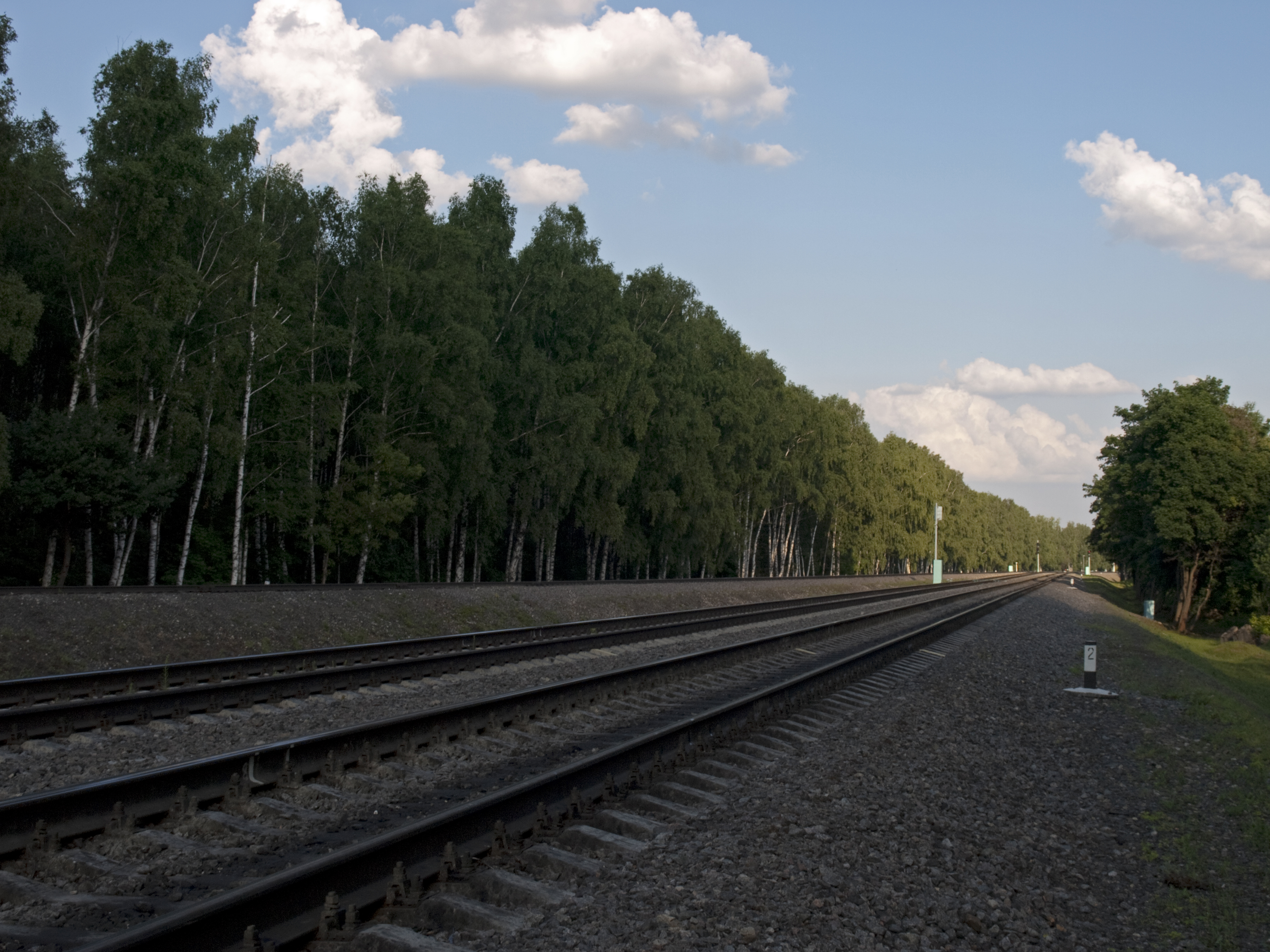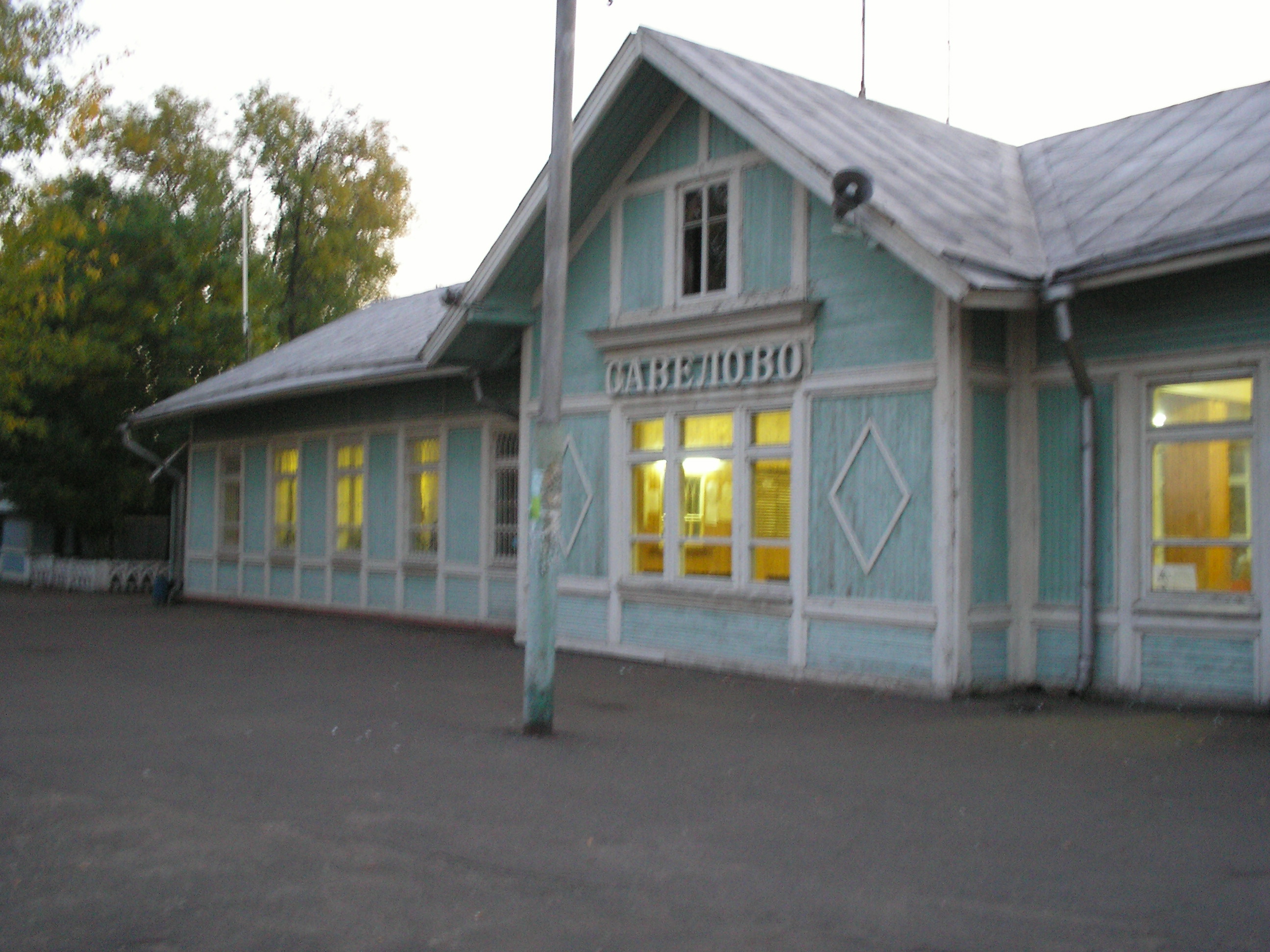|
Losinoostrovskaya Railway Station
Losinoostrovskaya (russian: Лосиноостровская) is a railway station located in Losinoostrovsky District of Moscow, Russia. The station serves suburban traffic of Yaroslavsky suburban railway line by Moscow Railway. The southbound trains terminate at Moscow Yaroslavskaya railway station in Moscow. The northbound trains terminate at the stations of , , , , , , , , , Alexandrov I, and . All suburban trains stop at Losinoostrovskaya. The station is operated by the Moscow Railway. The adjacent station in the northern direction is Los, and the one in the southern direction is Rostokino. Losinoostrovskaya has access to Menzhinskogo Street, Rudnevoy Street, and Anadysrky Proyezd (west), as well as to Dudinka Street and Khibinsky Proyezd (east). The public bus traffic is organized. The station is surrounded by a residential area. History The first summer houses were constructed in the area in 1898. In the same year, a railway station, Platform of the 10th versta (russian ... [...More Info...] [...Related Items...] OR: [Wikipedia] [Google] [Baidu] |
Moscow Railway
Moscow Railway (russian: Московская железная дорога) is a subsidiary of Russian Railways that handles half of Russia's suburban railway operations and a quarter of the country's passenger traffic. As of 2009 the railway, which has its headquarters near Komsomolskaya Square in Moscow, employed 73 600 people.http://mzd.rzd.ru/ It manages railway services in much of Central Russia, including Moscow and Moscow Oblast (all railways except the railroad to Saint Petersburg, which is managed by October Railway), Smolensk, Vladimir, Ryazan, Tula, Kaluga, Bryansk, Oryol, Lipetsk, and Kursk Oblasts. Railway lines * Ryazansky suburban railway line *Kazansky suburban railway line *Gorkovsky suburban railway line * Kursky suburban railway line * Paveletsky suburban railway line * Kiyevsky suburban railway line * Belorussky suburban railway line *Rizhsky suburban railway line *Savyolovsky suburban railway line *Yaroslavsky suburban railway line *Little Ring of the Mo ... [...More Info...] [...Related Items...] OR: [Wikipedia] [Google] [Baidu] |
Losiny Ostrov National Park
Losiny Ostrov National Park (russian: Национальный парк "Лосиный Остров", literally - '' Elk (Moose) Island'') is the second oldest national park of Russia (after Sochi National Park). It is located in Moscow and Moscow Oblast. It is the largest urban park in Europe. Losiny Ostrov is one of a few locations in Moscow where one can see wild animals in their natural environment, including the moose. In total there are 44 species of mammals and 170 bird species, 9 amphibian species, 5 reptile species and 19 fish species. Geography The total area of the national park in 2001 was 116.21 km², (28,717 acres). Forest occupied 96.04 km² (83% of area) of the total, of which 30.77 km² (27%) fall within the boundaries of Moscow city. Other land types in the park include 1.69 km² (2%) of water and 5.74 km², or 5% of swamp. An additional 66.45 km² is reserved for expansion of the park. The park is divided into the three functi ... [...More Info...] [...Related Items...] OR: [Wikipedia] [Google] [Baidu] |
Railway Stations Of Moscow Railway
Rail transport (also known as train transport) is a means of transport that transfers passengers and goods on wheeled vehicles running on rails, which are incorporated in tracks. In contrast to road transport, where the vehicles run on a prepared flat surface, rail vehicles (rolling stock) are directionally guided by the tracks on which they run. Tracks usually consist of steel rails, installed on sleepers (ties) set in ballast, on which the rolling stock, usually fitted with metal wheels, moves. Other variations are also possible, such as "slab track", in which the rails are fastened to a concrete foundation resting on a prepared subsurface. Rolling stock in a rail transport system generally encounters lower frictional resistance than rubber-tyred road vehicles, so passenger and freight cars (carriages and wagons) can be coupled into longer trains. The operation is carried out by a railway company, providing transport between train stations or freight customer facilit ... [...More Info...] [...Related Items...] OR: [Wikipedia] [Google] [Baidu] |
Railway Stations In Moscow
Rail transport (also known as train transport) is a means of transport that transfers passengers and goods on wheeled vehicles running on rails, which are incorporated in tracks. In contrast to road transport, where the vehicles run on a prepared flat surface, rail vehicles (rolling stock) are directionally guided by the tracks on which they run. Tracks usually consist of steel rails, installed on sleepers (ties) set in ballast, on which the rolling stock, usually fitted with metal wheels, moves. Other variations are also possible, such as "slab track", in which the rails are fastened to a concrete foundation resting on a prepared subsurface. Rolling stock in a rail transport system generally encounters lower frictional resistance than rubber-tyred road vehicles, so passenger and freight cars (carriages and wagons) can be coupled into longer trains. The operation is carried out by a railway company, providing transport between train stations or freight customer facili ... [...More Info...] [...Related Items...] OR: [Wikipedia] [Google] [Baidu] |
Moscow Savyolovsky Railway Station
Savyolovsky station (russian: Савёловский вокза́л, ''Savyolovsky vokzal''), alternatively spelled ''Savyolovskiy'', ''Savelovsky'' or ''Savelovskiy'', is one of the ten main railway stations in the Maryina roshcha District of Moscow. It serves suburban directions north of the city. Its initial name was ''Butyrsky vokzal'' (the station itself is still called ''Moscow Butyrskaya'') because of Butyrskaya Zastava Square, which also gave name to the nearby Butyrka prison. History The station was built from 1897 to 1902, along a long railway to the towns of Kashin, Kalyazin, Uglich, and Rybinsk. The modern name of the station originates from the name of a village Savyolovo (now a district of the town of Kimry) situated along the line. As the line was built by a private company, the place of the rail station was initially built outside Moscow next to the outpost of Butyrka. Initially known as Butyrsky station, the station lacks the ornateness and grandeur of Mosc ... [...More Info...] [...Related Items...] OR: [Wikipedia] [Google] [Baidu] |
Savyolovo
Savyolovo (russian: Савёлово) is a microdistrict of the town of Kimry in Tver Oblast, Russia. It lies on the right bank of the Volga River and is connected to the left-bank part of Kimry by a bridge over the Volga (the longest bridge in Tver Oblast). The expansion of the ancient village of Savyolovo at the beginning of the 20th century was due to the opening there in 1900 of a railway station on a new direct line to Moscow. The station was chiefly intended to serve the town of Kimry, with which Savyolovo eventually merged, on the opposite bank of the river. Railway station The station is the northern terminus of the Savyolovsky suburban railway line from the Savyolovsky Rail Terminal in Moscow via Dmitrov and Taldom. Savyolovo has given its name to the line itself, as well as its terminus (Savyolovsky Terminal) and a number of related toponyms in Moscow (Savyolovskaya (Bolshaya Koltsevaya line), Savyolovskaya (Serpukhovsko–Timiryazevskaya line) Metro station, Savy ... [...More Info...] [...Related Items...] OR: [Wikipedia] [Google] [Baidu] |
Kimry
Kimry (russian: Ки́мры), formerly Kimra (), is a town in the south of Tver Oblast, Russia, located on the Volga River at its confluence with the Kimrka River, to the east of Tver. Population: History The town was known as Kimra until the beginning of the 20th century; the name is probably of Finnic or Baltic origin. It was first mentioned in 1546 as a selo belonging to Ivan the Terrible. It belonged to Russian Tsars until 1677 and then was given to the Saltykov family. In 1847, the inhabitants bought themselves out, and Kimra quickly developed into a busy shoemaking and trading village on the left bank of the Volga (a boot appears on the town's coat of arms). Théophile Gautier wrote in his ''Voyage en Russie'' (1867): "Kimra est célèbre pour ses bottes comme Ronda pour ses guêtres" (Kimra is famous for its shoes as Ronda for its gaiters). The district on the right bank of the Volga, known as Savyolovo, started to develop in 1901, when a railway connected the place to ... [...More Info...] [...Related Items...] OR: [Wikipedia] [Google] [Baidu] |
Mikhail Babushkin
Mikhail Babushkin (russian: Михаи́л Серге́евич Ба́бушкин; October 6, 1893 – May 18, 1938) was a Soviet polar aviator and a Hero of the Soviet Union (June 27, 1937). Together with Mikhail Vodopyanov, he was the first to land an airplane on the North Pole. Biography Mikhail Babushkin was born in a village of Bordino (which was merged into the city of Moscow in 1960), started military service in 1914, graduated from Gatchina aviation school (one of the first Russian aviation schools) in 1915. Since 1923 he served in the Arctic aviation. He took part in an expedition to rescue Umberto Nobile in 1928, and in the Chelyuskin expedition in 1933. He took part in the flights to the Soviet drifting ice station "North Pole-1" in 1937. Between 1937 and 1938, Mikhail Babushkin participated in a search for Sigizmund Levanevsky. He died in 1938 in a flight accident and was interred at the Novodevichy Cemetery. Mikhail Babushkin was also a recipient of the Ord ... [...More Info...] [...Related Items...] OR: [Wikipedia] [Google] [Baidu] |
Little Ring Of The Moscow Railway
The Little Ring of the Moscow Railways (MK MZD, russian: Малое кольцо Московской Железной Дороги), is a orbital railway in Moscow. Built between 1902 and 1908 as ''MOZD'' (''Moscow Encircle Railway'', russian: Московская Окружная Железная Дорога, or just ''Encircle Line'', russian: Окружная линия) for mixed use railway traffic, after 1934 the railway was only used for cargo traffic. During the 2010s, the railway was converted to be used for commuter rail service and allows free transfers with the Moscow Metro; the passenger service on Moscow Ring Railway started on September 10, 2016, as the Moscow Central Circle. The line is operated by Russian Railways' Moscow subsidiary. History In 1800, the Kamer-Kollezhsky Val became the legal outer border of Moscow. In 1879, some additional areas, including Sokolniki, were annexed to the city; however, at the time Moscow was encircled by a number of further ... [...More Info...] [...Related Items...] OR: [Wikipedia] [Google] [Baidu] |
Losinoostrovsky District
Losinoostrovsky District (russian: Лосиноостро́вский райо́н) is an administrative district (raion) of North-Eastern Administrative Okrug, and one of the 125 raions of Moscow, Russia. It is 14 km north of the Moscow city center, located just inside the Moscow Ring Road, with Moscow Oblast to the north, Severnoye Medvedkovo District to the west, Babushkinsky District, Moscow, Babushkinsky district to the south, and Yaroslavsky District, Moscow, Yarosloavsky District to the east. The area of the district is . Population: 72,100 (2017 est.). Although its name coincides with Losiny Ostrov National Park, the district does not even border the park. Its name in fact refers to Losinoostrovskaya railway station, in turn named after the park. See also *Administrative divisions of Moscow References Notes Sources {{coord, 55, 53, N, 37, 42, E, region:RU-MOW_type:adm2nd_source:kolossus-ruwiki, display=title Districts of Moscow North-Eastern Administrative Okr ... [...More Info...] [...Related Items...] OR: [Wikipedia] [Google] [Baidu] |




